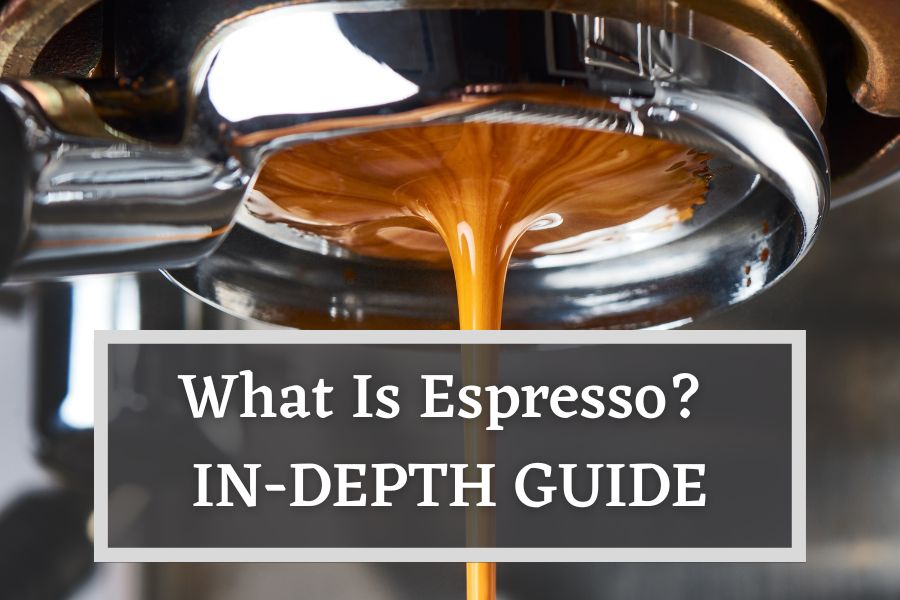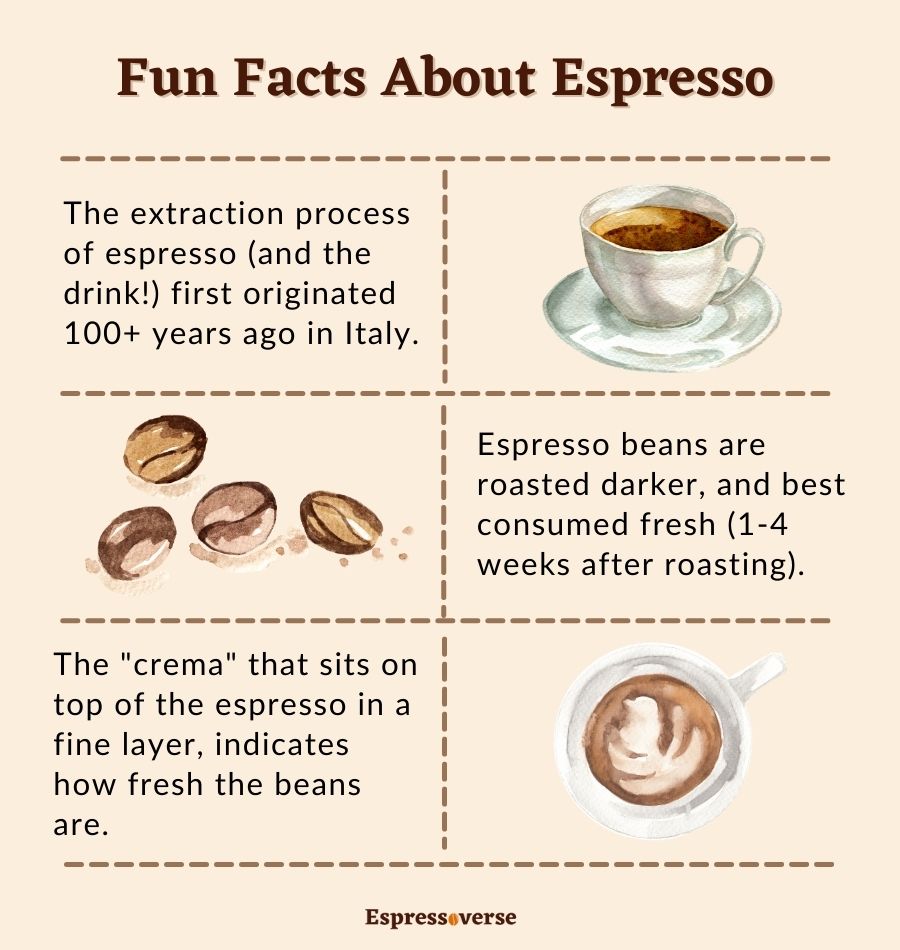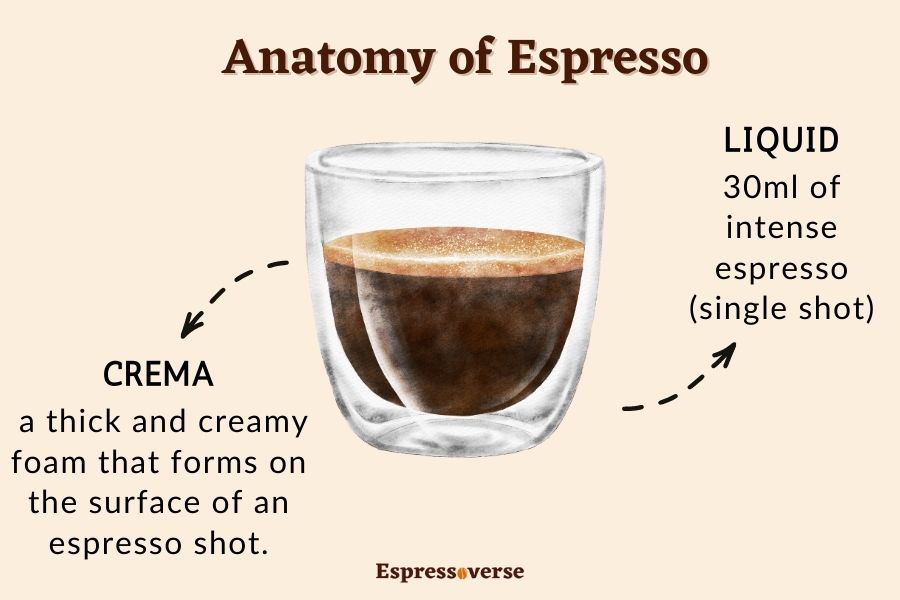Are you a fan of espresso? If so, then you know that it is one of the most popular and sought-after beverages around the world. But what is espresso exactly?
Espresso is an intense, full-bodied coffee beverage made by forcing pressurized hot water through finely-ground coffee beans.
It usually has a thick creamy consistency, a distinctive golden-brown colour and an aromatic fragrance of freshly brewed coffee with a lingering aftertaste of bittersweet caramel tones.
Espresso has become the foundation for many other coffee variations such as cappuccino, latte and macchiato. It is also often enjoyed straight without any additional ingredients or flavours.
So what makes this caffeinated drink so special?
In this blog post, we’ll explore all things espresso—we’ll discuss how it is made, its origin story, as well as techniques for making perfect espressos at home.
Keep reading if you are interested in mastering the art of Espresso!

What Is Espresso?
Espresso is a type of concentrated coffee that is made from finely ground and lightly roasted coffee beans, which are then brewed through a process of forcing pressurized hot water through them.
This method produces a small amount of highly concentrated espresso that has a unique flavour and aroma that can’t be achieved with other brewing methods.
The amount of time it takes to make an espresso drink varies depending on the type of machine and grind used but usually takes between 25-30 seconds.
Who Invented Espresso?
The history of espresso dates back to 1884 when Angelo Moriondo patented an “improvement in the machinery to make and distribute steam or hot water for beverages”.
This was then improved upon by Luigi Bezzera who patented his innovative design for making espressos in 1901.
Other inventors continued to build upon these designs over the following years, resulting in the invention of automatic espresso machines found in cafes today.

Espresso has come a long way since its inception over 100 years ago, becoming one of our most popular caffeinated beverages today enjoyed all over the world.
By the way, if you are an espresso beginner and you don’t own a machine yet, but you would like to, check out our best espresso machines for beginners.
How is Espresso Made?
Espresso is made from coffee beans. It is not the same as coffee though. There is a difference between coffee and espresso.
The process of turning a coffee bean into an espresso bean begins with harvesting. The beans are usually hand-picked, although in some cases they are machine-harvested.
After harvesting, the beans must be processed in order to remove any impurities and separate them from their husks. This can be done using a mechanical process or by using water.
After the beans have been processed, they are roasted in large drums at temperatures up to 480°F (249°C). During roasting, the chemical composition of the beans is changed and flavours like caramelization, sweetness and bitterness develop depending on how long they’re roasted.
Once the desired roast level has been achieved, the beans are then ground into a very fine powder that’s suitable for brewing espresso.
The grinding process can either be done manually with a hand grinder or automatically with an electric grinder. The grind size is important as it affects the extraction rate during brewing; finer grinds will give more flavour but will also require more pressure during extraction.
Once the espresso powder is ready, you can begin the brewing process.
How Is Espresso Brewed?
Espresso is usually brewed using espresso machines. But there are exceptions to this rule.
When it comes to preparing a perfect espresso drink, I also use special equipment like specialized pumps, heavy metal portafilters, precision grinders, and tamper tools.
Here is a step-by-step:
First, start by grinding the beans. Freshly ground espresso beans will give you the best flavour, so it’s worth the extra effort of using a hand grinder rather than pre-ground coffee.
Make sure to use a fine grind setting for espresso, as this will ensure that the brewing process isn’t too slow or too fast. This way, you will get the best out of the taste and texture of espresso.
I usually grind the beans into a portafilter before tamping them down with even pressure using a tamper tool.
Then I set the portafilter into its designated space on the espresso machine where hot water is forced through it under pressure at a specific temperature range between 195-205 degrees Fahrenheit (90-96 Celsius) for about 25-30 seconds.
During this process, crema forms on top of the shot which gives it its unique texture and mouthfeel.
After this process is complete, you get an intensely flavoured concentrated shot of coffee known as espresso. And that’s how it is brewed.
It is this combination of roasting techniques and grinding sizes as well as precise brewing temperatures and pressures that make espresso so unique and delicious!
To create different types of espresso drinks from this shot alone, you simply add various amounts and combinations of liquids like steamed milk or foamed milk along with syrups or liqueurs for extra flavours, such as in cappuccinos or mochas.
What Makes a Good Espresso?
Overall, creating great espresso requires attention to detail throughout every step.
From properly selecting and grinding fresh beans, applying the perfect amount of tamping pressure, using filtered water at just the right temperature, and timing extraction precisely in order to achieve optimal flavour potential from each brew.
In the end, you should get a cup of at least 30ml of espresso coffee and a thick and creamy foam at the top – also known as Crema.

To start with, freshly roasted beans are essential for making a delicious espresso.
The beans should be as fresh as possible – within a couple of days of roasting or grinding – because this is when they contain the most flavour compounds.
Additionally, freshly-ground beans will yield more flavorful results than pre-ground coffee.
As mentioned earlier, the ideal grind size for espresso is fine but not powdery; it should feel similar to table salt when pinched between your fingers.
Next, the correct amount of tamping pressure is essential in order to achieve an even extraction and maximize flavour potential without over-extracting or under-extracting the beans.
It’s also important to use filtered water with a temperature between 194°F (90°C) and 203°F (95°C) in order to get the best flavour from your espresso.
Lastly, timing is key – pulling shots too quickly can cause your espresso to taste sour while too long can result in bitter flavours due to over-extraction.
With these ingredients, your espresso will turn out creamy, sweet, and complex in flavour.
How is Espresso Served?
Espresso is typically served in demitasse cups, which are small and have a handle for easy drinking.
Furthermore, it is usually served as a single shot of between 1-2 ounces of liquid, but can also be made as a double shot or even a triple shot if desired.
The perfect espresso should be smooth and balanced with a thick layer of golden crema on top. It should have notes of sweet caramel and sometimes chocolate, depending on the blend used.
When it is served, it should be slightly warm to the touch or slightly cool if preferred.
Espresso may be enjoyed either straight up or with added milk, sugar or other flavourings according to personal preference.
Additionally, some traditional Italian bars may serve espresso with a glass of water alongside it for palate-cleansing purposes. Read more about how to drink espresso.
How To Store Espresso?
Storing espresso correctly is essential to ensure that it maintains its flavour and freshness. Espresso beans that are exposed to air or humidity can start to lose their flavour quickly.
To keep your espresso as fresh as possible, you should store it away from both of these elements.
The best place to store your espresso beans is in an airtight container. Ideally, this container should be opaque and made from a material such as glass, ceramic, or metal.
This will help keep out moisture and light which can degrade the flavours of espresso quickly.
Additionally, make sure the container has a tight-fitting lid so that no air can escape or enter the container.
You’ll also want to make sure that the container you use isn’t too big for your needs. Too much empty space within the container means more oxygen that could potentially spoil your espresso beans.
Try to look for a container just big enough for the amount of espresso you buy at any given time.
If you don’t have an airtight container, you may also choose to store the espresso beans in a resealable zip-top bag or a similar type of plastic pouch.
While not ideal, this option can still work provided that they are not kept in overly humid conditions and that they are stored away from heat sources such as direct sunlight or stoves/ovens.
Finally, if you need to store your espresso for longer than two weeks, consider putting them in the freezer—just make sure to thaw them before using them!
Freezing helps preserve their flavour by keeping out moisture and locking in their natural oils and fragrances. However, remember to keep the ground coffee in tightly sealed containers—otherwise, condensation may ruin their taste!
How To Order Espresso?
Let’s say that you find yourself in Italy one day soon. You will want to know how to order your espresso properly, right? No problem!
Remember that there are four main types of clean espresso:
- Single Shot (Espresso)
- Short Espresso (Ristretto)
- Long Espresso (Lungo)
- Double Espresso (Doppio)

Ristretto, which means “short” in Italian, is an espresso shot made with half the amount of water as a normal shot would require.
As a result, it has less caffeine but is much more intense in flavour due to the higher concentration of dissolved solids in each sip.
Doppio is double the amount of espresso used for a single shot (double ristretto).
The double shot allows for more crema (the foam on top) and results in an even stronger flavour profile than ristretto or regular espresso shots.
Lungo, which means “long” in Italian, is an espresso shot with twice the amount of water as would normally be used for a regular single-serve espresso shot.
This makes it weaker than both ristretto and doppio shots but still packs plenty of flavour and aroma into each sip thanks to its longer extraction time versus regular shots which are quickly extracted under pressure.
These are the main versions of espresso you need to know about when ordering in Italy (or in your local Starbucks). If you want to learn more, here is our list of popular espresso drinks.
Espresso FAQs
Is espresso a type of coffee bean?
No. Espresso is actually a brewing method that uses very hot water which is forced through a specific amount of tightly packed, finely ground coffee beans. The beans used are usually darker roasted than other types of beans, to give them the signature boldness associated with espresso beverages.
Why is espresso so strong?
The unique strength of espresso is due to a combination of factors, including the specific grind of the beans used, the amount of pressure applied during preparation, the brewing process, and the speed at which it is consumed.
What is espresso Crema?
Espresso crema is a thick and creamy foam that forms on the surface of an espresso shot. It is made up of emulsified oils, brewed coffee solids, and air bubbles. It is created when water passes through finely ground coffee beans at high pressure, extracting flavour and oils from the bean.
What is the ideal grind size for espresso?
The ideal grind size for espresso can vary based on the type of coffee beans used, the pressure of your machine, and how finely you wish to extract the flavours of the beans. Generally speaking, espresso should be ground to a very fine consistency – almost like table salt.
Now You Know What Espresso Is
So there you have it: a crash course in espresso. I hope this has answered some of your burning questions such as what is espresso, how it is made, and more.
Now that you know all this, you can impress your friends with your knowledge the next time you’re out for coffee. Who knows, maybe you’ll even be inspired to make your own espresso at home.
Thanks for reading!
Here is also a guide on the difference between espresso and americano in case you want to keep exploring the wonderful world of espresso.
